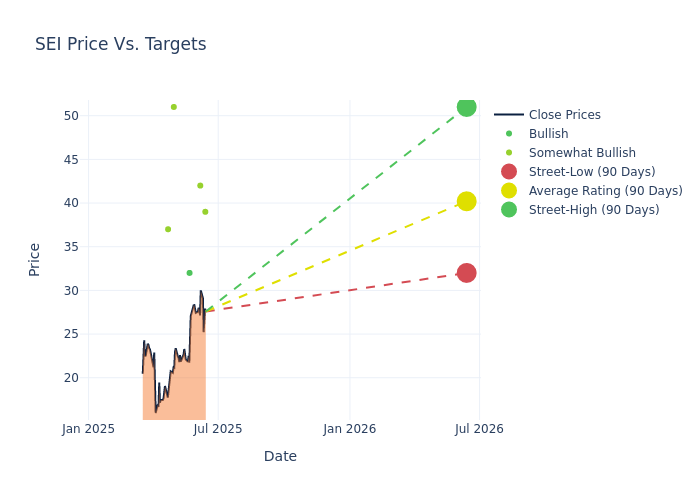The Analyst Verdict: Solaris Energy In The Eyes Of 5 Experts
In the preceding three months, 5 analysts have released ratings for Solaris Energy (NYSE:SEI), presenting a wide array of perspectives from bullish to bearish.
The table below provides a concise overview of recent ratings by analysts, offering insights into the changing sentiments over the past 30 days and drawing comparisons with the preceding months for a holistic perspective.
| Bullish | Somewhat Bullish | Indifferent | Somewhat Bearish | Bearish | |
|---|---|---|---|---|---|
| Total Ratings | 1 | 4 | 0 | 0 | 0 |
| Last 30D | 0 | 1 | 0 | 0 | 0 |
| 1M Ago | 1 | 1 | 0 | 0 | 0 |
| 2M Ago | 0 | 2 | 0 | 0 | 0 |
| 3M Ago | 0 | 0 | 0 | 0 | 0 |
Analysts have set 12-month price targets for Solaris Energy, revealing an average target of $40.2, a high estimate of $51.00, and a low estimate of $32.00. Observing a downward trend, the current average is 19.6% lower than the prior average price target of $50.00.

Understanding Analyst Ratings: A Comprehensive Breakdown
The perception of Solaris Energy by financial experts is analyzed through recent analyst actions. The following summary presents key analysts, their recent evaluations, and adjustments to ratings and price targets.
| Analyst | Analyst Firm | Action Taken | Rating | Current Price Target | Prior Price Target |
|---|---|---|---|---|---|
| J.R. Weston | Raymond James | Announces | Outperform | $39.00 | - |
| David Anderson | Barclays | Announces | Overweight | $42.00 | - |
| Scott Gruber | Citigroup | Announces | Buy | $32.00 | - |
| Derek Podhaizer | Piper Sandler | Raises | Overweight | $51.00 | $50.00 |
| Bobby Brooks | Northland Capital Markets | Announces | Outperform | $37.00 | - |
Key Insights:
- Action Taken: Analysts respond to changes in market conditions and company performance, frequently updating their recommendations. Whether they 'Maintain', 'Raise' or 'Lower' their stance, it reflects their reaction to recent developments related to Solaris Energy. This information offers a snapshot of how analysts perceive the current state of the company.
- Rating: Gaining insights, analysts provide qualitative assessments, ranging from 'Outperform' to 'Underperform'. These ratings reflect expectations for the relative performance of Solaris Energy compared to the broader market.
- Price Targets: Analysts provide insights into price targets, offering estimates for the future value of Solaris Energy's stock. This comparison reveals trends in analysts' expectations over time.
To gain a panoramic view of Solaris Energy's market performance, explore these analyst evaluations alongside essential financial indicators. Stay informed and make judicious decisions using our Ratings Table.
Stay up to date on Solaris Energy analyst ratings.
If you are interested in following small-cap stock news and performance you can start by tracking it here.
Discovering Solaris Energy: A Closer Look
Solaris Energy Infrastructure Inc provides services in the oil and gas industry. Its solutions are Solaris software suite, Fluid management system, Automated control systems, Field services, Last mile management, Wet sand solutions, Power Solutions, and Integrated wellsite solution. Its segment include Solaris Power Solutions and Solaris Logistics Solutions. It derives maximum revenue from Solaris Logistics Solutions segment.
Solaris Energy: Delving into Financials
Market Capitalization Analysis: Falling below industry benchmarks, the company's market capitalization reflects a reduced size compared to peers. This positioning may be influenced by factors such as growth expectations or operational capacity.
Revenue Growth: Solaris Energy's revenue growth over a period of 3M has been noteworthy. As of 31 March, 2025, the company achieved a revenue growth rate of approximately 86.08%. This indicates a substantial increase in the company's top-line earnings. As compared to competitors, the company surpassed expectations with a growth rate higher than the average among peers in the Energy sector.
Net Margin: The company's net margin is below industry benchmarks, signaling potential difficulties in achieving strong profitability. With a net margin of 4.01%, the company may need to address challenges in effective cost control.
Return on Equity (ROE): Solaris Energy's ROE is below industry averages, indicating potential challenges in efficiently utilizing equity capital. With an ROE of 1.41%, the company may face hurdles in achieving optimal financial returns.
Return on Assets (ROA): Solaris Energy's ROA falls below industry averages, indicating challenges in efficiently utilizing assets. With an ROA of 0.45%, the company may face hurdles in generating optimal returns from its assets.
Debt Management: Solaris Energy's debt-to-equity ratio stands notably higher than the industry average, reaching 0.91. This indicates a heavier reliance on borrowed funds, raising concerns about financial leverage.
Analyst Ratings: Simplified
Benzinga tracks 150 analyst firms and reports on their stock expectations. Analysts typically arrive at their conclusions by predicting how much money a company will make in the future, usually the upcoming five years, and how risky or predictable that company's revenue streams are.
Analysts attend company conference calls and meetings, research company financial statements, and communicate with insiders to publish their ratings on stocks. Analysts typically rate each stock once per quarter or whenever the company has a major update.
Some analysts also offer predictions for helpful metrics such as earnings, revenue, and growth estimates to provide further guidance as to what to do with certain tickers. It is important to keep in mind that while stock and sector analysts are specialists, they are also human and can only forecast their beliefs to traders.
Breaking: Wall Street's Next Big Mover
Benzinga's #1 analyst just identified a stock poised for explosive growth. This under-the-radar company could surge 200%+ as major market shifts unfold. Click here for urgent details.
This article was generated by Benzinga's automated content engine and reviewed by an editor.
 Wall Street Journal
Wall Street Journal